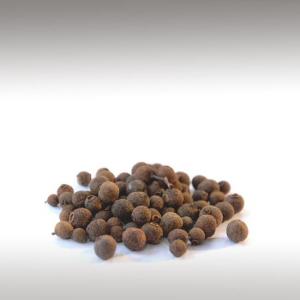
ALLSPICE ESSENTIAL OIL (PIMENTA DIOICA) - ESSENTIAL OILS

BASE / GENERAL DATA
Information submited: May 4, 2015 By: OperaDreamhouse
Botanical Name: Pimenta dioica
Common Method of Extraction: Steam distillation
Part Typically Used: Leaves and fruits
Color: Yellow - brown
Consistency: Thin
Perfumery Note: Top
Strength of Initial Aroma: Warm, spicy, woody scent with a mild camphor-like note, like a combination of cinnamon, clove and pepper.
Allspice is so called pimento because it tastes like a combination of cloves, juniper berries, cinnamon and pepper.
The oil has a sweet, spicy, clove - like odor, fruitier than the pimenta leaf oil which is less expensive. It has a fresh and clean top note and a long - lasting, sweet, balsamic - spicy body note with hints of tea - like undertones.
In perfumery, Allspice oil is typically used as a modifier in men’s fragrances, particularly in spicy fougeres and in oriental types.
Allspice, also called Jamaica pepper, Pepper, Myrtle pepper, Pimenta, Turkish Yenibahar, Pimento, English pepper or Newspice, is the dried unripe fruit of Pimenta dioica, a midcanopy tree native to the Greater Antilles, southern Mexico, and Central America, now cultivated in many warm parts of the world.
The name "Allspice" was coined as early as 1621 by the English, who thought it combined the flavour of Cinnamon, Nutmeg, and Cloves.
The tree begins to fruit when three years old and is in full bearing after four years. The flowers appear in June, July and August and are quickly succeeded by the berries.
The special qualities of the fruit reside in the rind of the berries. It loses its aroma on ripening, owing to loss of volatile oil, and the berries are therefore collected as soon as they have attained their full size, in July and August, but while unripe and green.
It begins to produce fruit in its third year, with each fruit containing two kidney-shaped green seeds, which turn glossy black when ripe.
The Allspice tree, classified as an evergreen shrub, reaches heights between 10 and 18 m. Allspice can be a small, scrubby tree, quite similar to the Bay laurel in size and form. It can also be a tall, canopy tree, sometimes grown to provide shade for Coffee trees planted underneath it. It can be grown outdoors in the tropics and subtropics with normal garden soil and watering.
Allspice was encountered by Christopher Columbus on the island of Jamaica during his second voyage to the New World. It was introduced into European and Mediterranean cuisines in the 16th century. It continued to be grown primarily in Jamaica, though a few other Central American countries produced Allspice in comparatively small quantities.
Despite its popularity, cultivation outside its native region has been uncommon and often unsuccessful. Allspice thrives in warm climates and grows almost entirely in the western hemisphere. Due to its limited range, it is not well known in many parts of the world.
Chemical structure:
The main chemical components of Allspice oil are eugenol, menthyl eugenol, cineol, phellandrene and caryophyllene.
Allspice fruits contain 2 to 5% essential oil. The main components of the essential oil areeugenol, eugenol methyl ether, myrcene, 1,8-cineol and alpha-phellandrene. The eugenol content of essential oil of Jamaican allspice is 65 to 90%, but the eugenol content of Mexican allspice is much less.
Because of the high eugenol content (50-75%), Allspice oil is one of a handful of essential oils with a density slightly greater than water. There have been reports of a methyl eugenol chemotype of this oil as well, but the typical berry oil will contain 10-25%methyl eugenol anyway.
Common Method of Extraction: Steam distillation
Part Typically Used: Leaves and fruits
Color: Yellow - brown
Consistency: Thin
Perfumery Note: Top
Strength of Initial Aroma: Warm, spicy, woody scent with a mild camphor-like note, like a combination of cinnamon, clove and pepper.
Allspice is so called pimento because it tastes like a combination of cloves, juniper berries, cinnamon and pepper.
The oil has a sweet, spicy, clove - like odor, fruitier than the pimenta leaf oil which is less expensive. It has a fresh and clean top note and a long - lasting, sweet, balsamic - spicy body note with hints of tea - like undertones.
In perfumery, Allspice oil is typically used as a modifier in men’s fragrances, particularly in spicy fougeres and in oriental types.
Allspice, also called Jamaica pepper, Pepper, Myrtle pepper, Pimenta, Turkish Yenibahar, Pimento, English pepper or Newspice, is the dried unripe fruit of Pimenta dioica, a midcanopy tree native to the Greater Antilles, southern Mexico, and Central America, now cultivated in many warm parts of the world.
The name "Allspice" was coined as early as 1621 by the English, who thought it combined the flavour of Cinnamon, Nutmeg, and Cloves.
The tree begins to fruit when three years old and is in full bearing after four years. The flowers appear in June, July and August and are quickly succeeded by the berries.
The special qualities of the fruit reside in the rind of the berries. It loses its aroma on ripening, owing to loss of volatile oil, and the berries are therefore collected as soon as they have attained their full size, in July and August, but while unripe and green.
It begins to produce fruit in its third year, with each fruit containing two kidney-shaped green seeds, which turn glossy black when ripe.
The Allspice tree, classified as an evergreen shrub, reaches heights between 10 and 18 m. Allspice can be a small, scrubby tree, quite similar to the Bay laurel in size and form. It can also be a tall, canopy tree, sometimes grown to provide shade for Coffee trees planted underneath it. It can be grown outdoors in the tropics and subtropics with normal garden soil and watering.
Allspice was encountered by Christopher Columbus on the island of Jamaica during his second voyage to the New World. It was introduced into European and Mediterranean cuisines in the 16th century. It continued to be grown primarily in Jamaica, though a few other Central American countries produced Allspice in comparatively small quantities.
Despite its popularity, cultivation outside its native region has been uncommon and often unsuccessful. Allspice thrives in warm climates and grows almost entirely in the western hemisphere. Due to its limited range, it is not well known in many parts of the world.
Chemical structure:
The main chemical components of Allspice oil are eugenol, menthyl eugenol, cineol, phellandrene and caryophyllene.
Allspice fruits contain 2 to 5% essential oil. The main components of the essential oil areeugenol, eugenol methyl ether, myrcene, 1,8-cineol and alpha-phellandrene. The eugenol content of essential oil of Jamaican allspice is 65 to 90%, but the eugenol content of Mexican allspice is much less.
Because of the high eugenol content (50-75%), Allspice oil is one of a handful of essential oils with a density slightly greater than water. There have been reports of a methyl eugenol chemotype of this oil as well, but the typical berry oil will contain 10-25%methyl eugenol anyway.

SPIRITUAL PRACTISES DATA

MEDICINE / HEALTH DATA

BEAUTY / COSMETICS DATA

FOOD / COOKING DATA
COMMENTS
No comments.


